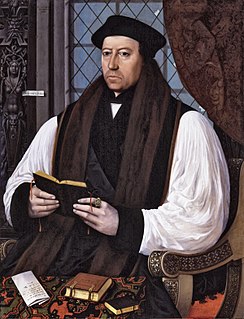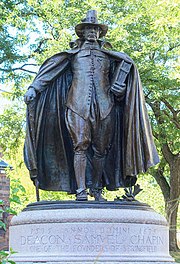
Elizabeth I was Queen of England and Ireland from 17 November 1558 until her death on 24 March 1603. Sometimes called the Virgin Queen, Gloriana or Good Queen Bess, Elizabeth was the last of the five monarchs of the House of Tudor.

The Elizabethan era is the epoch in the Tudor period of the history of England during the reign of Queen Elizabeth I (1558–1603). Historians often depict it as the golden age in English history. The symbol of Britannia was first used in 1572, and often thereafter, to mark the Elizabethan age as a renaissance that inspired national pride through classical ideals, international expansion, and naval triumph over Spain. The historian John Guy (1988) argues that "England was economically healthier, more expansive, and more optimistic under the Tudors" than at any time in a thousand years.

William Cecil, 1st Baron Burghley, was an English statesman, the chief advisor of Queen Elizabeth I for most of her reign, twice Secretary of State and Lord High Treasurer from 1572. In his description in the Encyclopædia Britannica Eleventh Edition, Albert Pollard wrote, "From 1558 for forty years the biography of Cecil is almost indistinguishable from that of Elizabeth and from the history of England."

Matthew Parker was an English bishop. He was the Archbishop of Canterbury in the Church of England from 1559 until his death in 1575. He was also an influential theologian and arguably the co-founder of a distinctive tradition of Anglican theological thought.
John Stubbs was an English pamphleteer, political commentator and sketch artist during the Elizabethan era.
The Acts of Supremacy are two acts passed by the Parliament of England in the 16th century that established the English monarchs as the head of the Church of England. The 1534 Act declared King Henry VIII and his successors as the Supreme Head of the Church, replacing the pope. The Act was repealed during the reign of the Catholic Queen Mary I. The 1558 Act declared Queen Elizabeth I and her successors the Supreme Governor of the Church, a title that the British monarch still holds.

The Elizabethan Religious Settlement is the name given to the religious and political arrangements made for England during the reign of Elizabeth I (1558–1603) that brought the English Reformation to a conclusion. The Settlement shaped the theology and liturgy of the Church of England and was important to the development of Anglicanism as a distinct Christian tradition.

The Tudor period occurred between 1485 and 1603 in England and Wales and includes the Elizabethan period during the reign of Elizabeth I until 1603. The Tudor period coincides with the dynasty of the House of Tudor in England whose first monarch was Henry VII. Historian John Guy (1988) argued that "England was economically healthier, more expansive, and more optimistic under the Tudors" than at any time in a hundred years.
The "Ornaments Rubric" is found just before the beginning of Morning Prayer in the Book of Common Prayer of the Church of England. It runs as follows:
"THE Morning and Evening Prayer shall be used in the accustomed Place of the Church, Chapel, or Chancel; except it shall be otherwise determined by the Ordinary of the Place. And the Chancels shalt remain as they have done in times past.
"And here is to be noted, that such Ornaments of the Church, and of the Ministers thereof, at all Times of their Ministration, shall be retained, and be in use, as were in this Church of England, by the Authority of Parliament, in the Second Year of the Reign of King Edward the Sixth."

William Strickland was an English landowner who sailed on early voyages of exploration to the Americas and is credited with introducing the turkey into England. In later life he was a prominent Puritan Member of Parliament.
England under Elizabeth I's reign, the Elizabethan Era, was ruled by the very structured and complicated Elizabethan government. It was divided into the national bodies, the regional bodies, the county, community bodies and the court system.

Richard Onslow was a 16th-century English lawyer and politician who served as Solicitor General from 1566 to 1569 and Speaker of the House of Commons. He was born in Shrewsbury, a younger son of Roger Onslow and his first wife Margaret Poyner.

The English Reformation took place in 16th-century England when the Church of England broke away from the authority of the Pope and the Roman Catholic Church. These events were, in part, associated with the wider European Protestant Reformation, a religious and political movement that affected the practice of Christianity in western and central Europe. Causes included the invention of the printing press, increased circulation of the Bible and the transmission of new knowledge and ideas among scholars, the upper and middle classes and readers in general. The phases of the English Reformation, which also covered Wales and Ireland, were largely driven by changes in government policy, to which public opinion gradually accommodated itself.
Sir John Ernest Neale was an English historian who specialised in Elizabethan and Parliamentary history. From 1927 to 1956, he was the Astor Professor of English History at University College London.

Clement Throckmorton was an English landowner and Member of Parliament in the middle years of the 16th century.
Patrick "Pat" Collinson was an English historian, known as a writer on the Elizabethan era, particularly Elizabethan Puritanism. He was emeritus Regius Professor of Modern History, University of Cambridge, having occupied the chair from 1988 to 1996. He once described himself as "an early modernist with a prime interest in the history of England in the sixteenth and seventeenth centuries."

The reign of Elizabeth I of England, from 1558 to 1603, saw the start of the Puritan movement in England, its clash with the authorities of the Church of England, and its temporarily effective suppression as a political movement in the 1590s by judicial means. This of course led to the further alienation of Anglicans and Puritans from one another in the 17th century during the reign of King James (1603-1625) and the reign of King Charles I (1625-1649), that eventually brought about the English Civil War (1642-1651), the brief rule of the Puritan Lord Protector of England Oliver Cromwell (1653-1658), the English Commonwealth (1649-1660), and as a result the political, religious, and civil liberty that is celebrated today in all English speaking countries.
The Westminster Conference of 1559 was a religious disputation held early in the reign of Elizabeth I of England. Although the proceedings themselves were perfunctory, the outcome shaped the Elizabethan religious settlement.

The coronation of Queen Elizabeth I as queen regnant of England and Ireland took place at Westminster Abbey, London, on 15 January 1559. Queen Elizabeth I had ascended the throne at the age of 25 upon the death of her half-sister, Queen Mary I, on 17 November 1558. Mary had reversed the Protestant Reformation which had been started by her two predecessors, so this was the last British coronation to be conducted under the authority of the Roman Catholic Church. Historians view Elizabeth's coronation as a statement of her intention restore England to Protestantism, but to allow the continuation of some Catholic customs, a compromise known as the Elizabethan Settlement.

The 1st Parliament of Queen Elizabeth I was summoned by Queen Elizabeth I of England on 5 December 1558 and assembled on 23 January 1559. This Parliament would restore many of the laws created by Henry VIII and the English Reformation Parliament. Queen Elizabeth's 1st Parliament passed some 24 public statutes and 17 private measures by the time it was dissolved on 8 May 1559.












